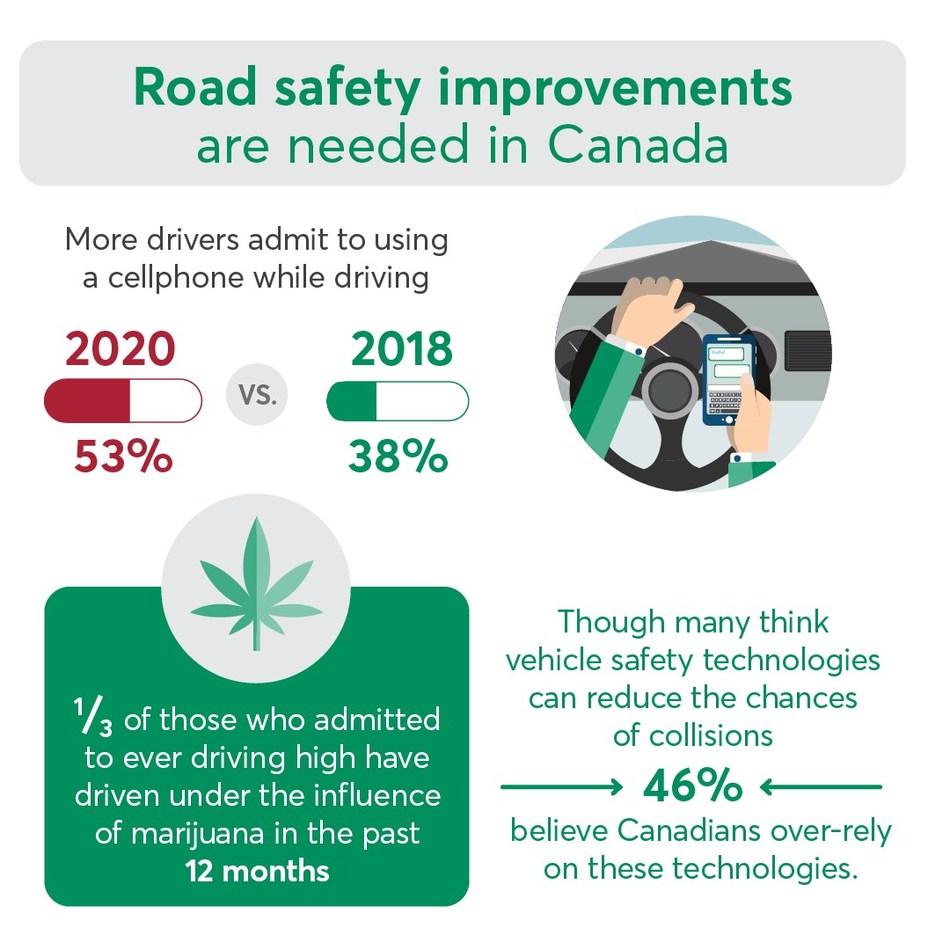Canadians have been diligently taking new safety precautions in 2020 to protect their health but the same can’t be said about some dangerous driving behaviours.
“For a few years now, Desjardins has been surveying Canadians on distracted driving, drug impaired driving and, more recently, vehicle safety technology. We do this to raise awareness on road safety issues and we are committed to reducing collisions, injuries and fatalities on our roads,” said Valérie Lavoie, President and Chief Operating Officer, Desjardins General Insurance Group.
According to Desjardins’s 2020 road safety survey:
- More drivers admit to using a cellphone while driving than before (53% in 2020 vs. 38% in 2018);
- 1/3 of those who admitted to ever driving high have driven under the influence of marijuana in the past 12 months;
- 67% of Canadians feel drivers are more likely to become distracted because they rely on advanced safety systems.
“Every fatality and every injury on our roads is one too many. We all have a responsibility to keep our roads safe by creating a distraction-free environment, staying sober while driving, and better understanding the benefits – but also the limitations – of vehicle safety technologies,” added Lavoie.
Distracted Driving
Distracted driving is a major concern for Canadians. Many still admit to being distracted by different factors while driving; cellphones being one of the most mentioned distractions. Among young drivers (16 to 34 years old), 60% admit to having driven distracted by a cellphone.
Top distracting factors:
- External environment (51%);
- Cellphone related (texting, talking, emailing) (48%);
- Changing console settings/infotainment systems (43%).
What would stop people from driving distracted? Shockingly, getting into a motor vehicle collision is ranked first at 41%, followed by increased fines at 26% and the possibility of auto insurance premiums going up (if fined) at 21%.
Drug Impaired Driving
Nearly two years after cannabis legalization, most people understand the dangers of driving under the influence of marijuana – 86% say they think it impairs driving skills – yet, of those who admitted to driving high, a third still admit to having driven under the influence of marijuana in the past 12 months.
Meanwhile, 15% of drivers have driven under the influence of a prescription drug at least once in their life.
Of greatest concern is that dangerous driving behaviours lead to other dangerous behaviours:
- People who drive under the influence of marijuana are more likely to have driven under the influence of prescription drugs (35% vs. 13%) or over-the-counter drugs (30% vs. 13%);
- People who drive while distracted by a cellphone are also more prone to drive under the influence of marijuana (14% vs. 6%), prescription drugs (20% vs. 10%) or over-the-counter drugs (21% vs. 9%).
This represents a dangerous accumulation of risk factors.
Vehicle Safety Technologies
Safety technologies in vehicles, such as lane departure or front collision warning, automatic emergency braking or any level of autonomous driving, are now more common: 32% of Canadians report having safety technologies in their vehicles.
While the majority of Canadians (69%) trust vehicle safety technologies, not all Canadians are convinced about the benefits of these technologies:
- 46% think Canadians are over-reliant on vehicle safety technologies;
- 79% think there should be more education on how to use;
- 72% wouldn’t trust self-driving vehicles.
Click here for full infographics
The web panel survey was conducted by Ad Hoc Research for Desjardins among Canadians aged 16 to 74 years old. A total of 3,104 respondents were surveyed.
